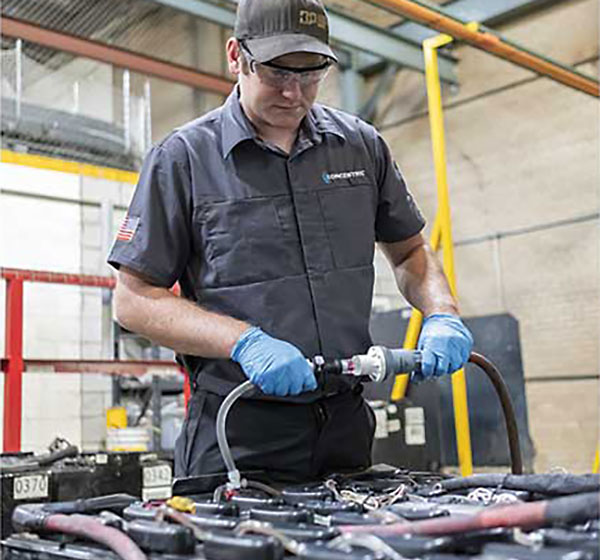The power side of lift truck battery and charger maintenance
Why best practices in battery and charger maintenance are essential to lift truck fleet operations and costs.
With the majority of lift trucks used indoors, including warehouses, typically running off batteries of some type, lift truck maintenance and battery system maintenance are really part of the same objective: Keep the fleet performing as expected at the lowest possible cost.
Sure, mechanical aspects of trucks like brakes or hydraulics need to be checked with daily inspections or preventative maintenance (PM) events, but if you aren’t paying close attention to batteries, chargers and charging best practices, your fleet could suffer.
“There are many maintenance needs that tend to be overlooked, but batteries and chargers should not be one of them, because they end up being in the top five areas for spend dollars over the total life of an electric forklift,” says Michael Galyen, regional vice president for Concentric, a company that offers lift truck fleet power services, including maintenance of batteries and chargers. The company also provides some embedded technician services for broader lift truck maintenance needs.
Electric lift truck fleets are in an ongoing state of transition, notes Galyen, with more companies getting away from battery rooms and battery swaps, and adopting more fast charging and opportunity charging of lithium-ion batteries, thin-plate pure lead batteries, or in some cases, with conventional lead acid batteries.
This transition to opportunity charging makes charger maintenance more important, adds Galyen, since with no battery waiting to swap in, the chargers must be effective in keeping busy fleets up and running.
“Facilities that run multiple shifts and six plus days per week are more common, yet, batteries have transitioned to opportunity, fast charging and rapid charging of lithium batteries where there is no change out of the power source,” Galyen says. “As a result, every minute the battery is plugged into the charger counts. Any changes in shift schedules, ambient temperature, duty cycle, even operators, can have a more profound impact on the productivity of a facility as it relates to the power put back into the battery from the charger.”
For starters, regular PMs should include a close look at issues with chargers and batteries, with PM frequency aligned to the level of use and wear, says Galyen. There are some specific things to check for on chargers, such as some units that have fans built in. In dusty environments, charger fans need to be checked to ensure they aren’t getting clogged. Generally, chargers are becoming smarter and more Internet connected, so it’s become important to keep software and firmware updated.
During maintenance checks on chargers, or through connectivity to connected chargers, it’s also critical to gather full data sets from the chargers, rather than just basic voltage readings.
Lithium batteries typically have built-in battery management system (BMS) technology that governs the charging profile to the battery, but for lead-acid batteries, the charger acts as “brains of the operation” for charging, making it essential to gather all available data.
One major thing operations managers should be doing is communicating closely with the maintenance team around expected upticks in fleet use and duty cycles to ensure the electric infrastructure can support the change, and to see if PM schedules or charging profiles need to adjust.
“If there’s significant change coming to the operations and the expected duty cycles, or the break schedules, you need to communicate these changes to the maintenance team to see if any adjustment to the maintenance schedule is needed, or some adjustment to what the chargers are doing needs to be made,” Galyen adds.
While telematics over lift truck fleets and batteries can provide value, Galyen warns that each operation needs a sufficient baseline of data to achieve a more dynamic and predictive approach to maintenance from telematics, with easy-to-use analytics to pinpoint what to adjust.
That said, telematics and smarter, more connected assets hold the potential to make electric lift truck fleets less costly as opportunity charging of lithium batteries becomes more prevalent.
“In many facilities, the battery chargers themselves are one of the largest energy demands,” Galyen says. “Therefore, a dramatic increase in output power required will impact peak power demand, resulting in the potential for utilities imposing a significant demand charge. As chargers evolve, the potential for adaptive charging techniques will also evolve. Ideally the IoT and telematics will learn usage patterns of vehicles, predicting the demand to come and tailor charger output to ensure enough available power while considering the economic factors of the power output.”

Article Topics
Concentric News & Resources
Concentric acquires Jantech, provider of uninterruptable power solutions OnPoint Group sells Concentric, citing focus on critical facility services sector Concentric acquires Hawaii-based Industrial Battery Solutions The power side of lift truck battery and charger maintenance Concentric acquires Texas Motive Solutions Concentric, part of OnPoint Group, acquires Industrial Power Products Concentric, part of OnPoint Group, acquires Mesa Technical Associates More ConcentricLatest in Materials Handling
Registration open for Pack Expo International 2024 Walmart chooses Swisslog AS/RS and software for third milk processing facility NetLogistik partners with Vuzix subsidiary Moviynt to offer mobility solutions for warehouses Materials Handling Robotics: The new world of heterogeneous robotic integration BSLBATT is looking for new distributors and resellers worldwide Lucas Watson appointed CSO for Körber’s Parcel Logistics business in North America Hyster recognizes Dealers of Distinction for 2023 More Materials HandlingAbout the Author
Subscribe to Materials Handling Magazine

Find out what the world's most innovative companies are doing to improve productivity in their plants and distribution centers.
Start your FREE subscription today.
April 2024 Modern Materials Handling

Latest Resources












